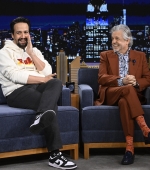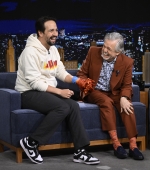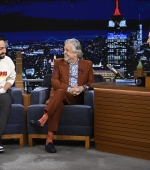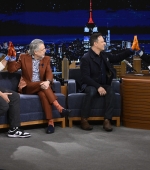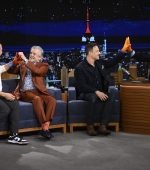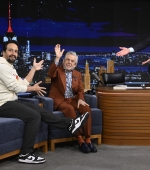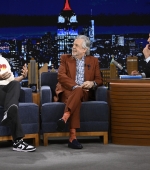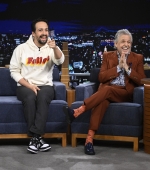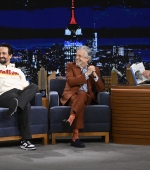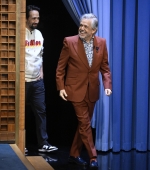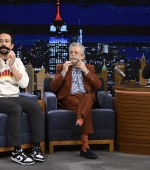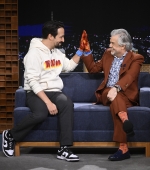An article written by Lin-Manuel Miranda features in the December issue of British Vogue. He writes about Mary Poppins Returns and his life in London.
Read the scans in our Gallery or the online version under the cut.
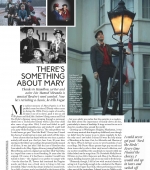
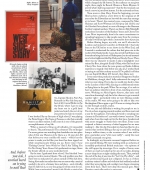
My earliest memory of Mary Poppins is of the padded cream box that all Disney videos came in during the ’80s. Every couple of months, I’d take it out of its sleeve, push it into an old VHS player and find Julie Andrews’ flying nanny and Dick Van Dyke’s chimney sweep jumping through a pavement sketch into a Technicolor fantasy world. Like every child who came of age after 1964, I tried and failed to spell supercalifragilisticexpialidocious and wished I could hold a tea party while floating in mid-air. The only problem was I could never get past “Feed the Birds”. Every time I heard the chorus, I would end up in tears and switch off the video.
It was a lesson that has stayed with me ever since: a perfect melody will wreck you. And yet, here I am, 30 years later starring in the follow-up to perhaps the greatest family musical of all time. It was just after I left the cast of Hamilton that I was asked to do Mary Poppns Returns, joining Emily Blunt, Meryl Streep and even original cast member Dick Van Dyke, in a sequel that comes a record-breaking 54 years after the original. Of course, if it had been a remake I would have turned it down — the original is too perfect to tamper with – but the idea that PL Travers had continued the Poppins novels and there was a fresh story to bring to life was irresistible. Mary’s world has always worked on many levels. As a child, of course, you’re just dazzled by the fantasy of this umbrella-wielding nanny and the world that she conjures — but as an adult, you realise that the narrative is a modern-day fable about the importance of family above all else, particularly in times of hardship. It rings as true for me as it does for countless fans around the world.
Growing up in Washington Heights, Manhattan, it was one of many musicals that shaped my childhood, even though we didn’t have the money to go to shows regularly. In fact, the only ones I saw before I turned 18 were the holy trinity of Broadway at the time: Cats, Les Miserables and Phantom of the Opera. What I did have access to were hundreds of cast recordings. My Puerto Rican parents kept pop records and show tunes side by side in their vinyl record collection, ‘and my mother would blast the soundtrack to Camelot while my father belted out the songs from The Unsinkable Molly Brown. I’d listen to Jesus Christ Superstar and Man of La Mancha on repeat, building characters and sets in my mind to fit the lyrics.
Ultimately, though, I fell in love with musical theatre by acting in it. I was lucky enough to be a student at the Hunter school on the Upper East Side, where performing arts form a key part of the curriculum. 1 played a son in Fiddler on the Roof, a farmer in Oklahoma!, munch kin in The Wizard of Oz Captain Hook in Peter Pan, Bernardo in West Side Story and, best of all, Conrad Birdie in Bye Bye Birdie, where I got to sing my heart out in a gold lame jacket and watch the rest of my year pretend to faint in wonder. I was hooked. By my first year of high school, I was playing the Pirate King in The Pirates of Penzance, a role that normally went to an older student. I still count it as one of the greatest accomplishments of my life.
When a musical is firing on all cylinders, it’s impossible to beat it. The performances! The costumes! The set design! I’ve never gotten over watching that chandelier rise into place when I first saw Phantom of the Opera as a 12-year-old. All that before you even consider the music — which has the power to make you feel like your heart has been ripped out while simultaneously lifting you up. Every time. I hear “Defying Gravity” from Wicked or “And I Am Telling You I’m Not Going” from Dream Girls performed on stage, I leave the theatre altered on some molecular level.
By the time I graduated from school, I had decided I was going to work in musical theatre. The only problem was that there were no real parts for Latinos outside of West Side Story. Seeing Rent me realise there was no reason why a musical needed to be set in a faraway time and place — and, critically, that if I didn’t do it, no one was going to tell my story for me. While I was at university, I wrote In the Heights, a musical set over three days in my family’s neighbourhood, which became my first Broadway show. Many years later, I wrote Hamilton, which changed my life forever. In the audience on any given night, the might be Barack Obama or Busta Rhymes. It proved what I had long suspected — that the best musicals can touch a nerve in just about anyone. it is the universal art form.
None more so than Mary from the beginning, our new film has been crafted as a love letter to the original, set 20 years after the Edwardian era but with the same key message at its heart. There’s the musical score, composed by Marc Shairnan and Scott Wittman (of Hairspray and Charlie and the Chocolate Factory) fame) as a sort of homage to the Sherman brothers’ original numbers. There’s our director Rob Marshall’s meticulous recreation of the Bankses’ house and Cherry Tree Lane. Most importantly, there’s the same commitment to spreading happiness: to take people away from the craziness of today’s world and give them a restorative shot of pure joy.
Before filming began, my wife, son and I relocated to London and immersed ourselves in British life. I had only been to the UK before to see shows in the West End, and I wanted to understand the culture that had given rise to the world of the Banks family. I soon discovered that Britain may boast about being the home of Shakespeare, but its real treasures are a lot less highbrow, like Dip Dabs and Fawlty Towers. Then, there was my character to master. I play a lamplighter once trained by Bert, alongside Emily’s Mary, who flies back into Cherry Tree Lane when the now-grown-up Banks children experience a tragedy. And before you ask, yes, I worked hard on trying to nail that cockney accent. If I’ve pulled it of then you can thank Ms Blunt (if I haven’t, then blame me).
It was only when production started at Shepperton Studios in Middlesex, though, that I fully understood the magic of what we were doing. Every day, we would step back in time to the London of the ’30s, dancing on cobblestoned streets or flying kites in the park. When I’m on stage, it’s a rush to have an audience directly in front of me, watching my every move. Working on Mary Poppins Returns, that same rush came from knowing I only had a few chances to get a musical number right — particularly when we were filming outside of the studio. We were never going to be able to take over Buckingham Palace again or get 120 men on vintage bicycles to ride through central London.
For me, the real difficulty is waiting for people to see it. You do a show-stopping musical number, and then must wait a year for the applause. I’m looking forward to sneaking into cinemas in December so I can watch viewers’ reactions. That said when I saw the rough cut for the first time I understood why actors struggle to watch their own films. Every scene conjured a distinct memory of what happened as we were making it — like the day I knocked my head and had to do a routine that involved lifting a flat cap on and off a swelling bump a million times, or the occasion when I was told to give a particular scene “a bit more welly” — surely the most British command ever given.
In hindsight, my favourite moment happened before we even started filming. We were working with an orchestra of incredibly professional British musicians — the epitome of the stiff-upper-lip stereotype. For a couple of hours, none of them so much as looked up for any of our jokes, keeping a razor-sharp focus on sight-reading the music. ens towards the end of the day, it was time for “Let’s Go Fly a Kite”— and their professional facade just collapsed. It was as if these academy-trained cellists and violinists had suddenly realised what they were playing and nostalgic tears began streaming down their faces. That’s how deep this musical goes. Mary Poppins: practically perfect in every way.
